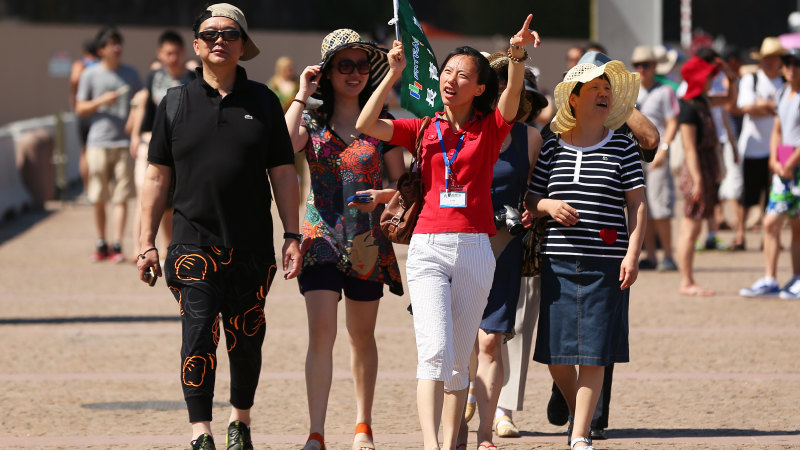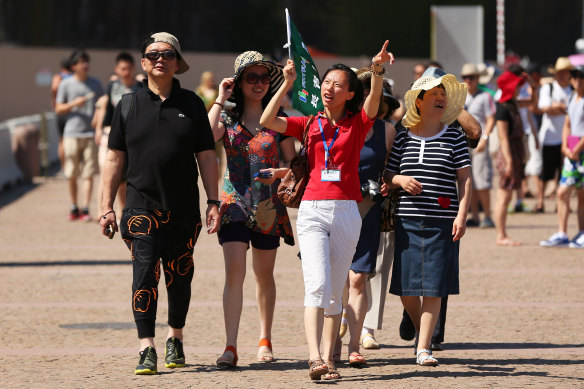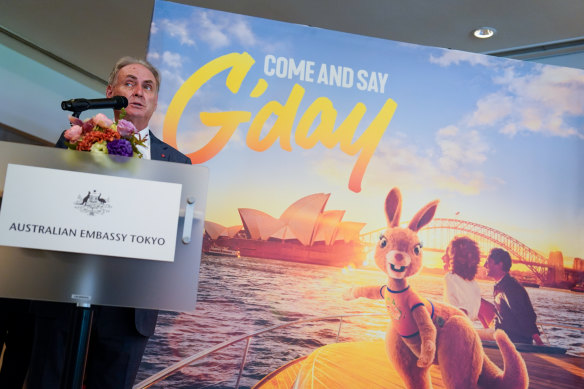Save articles for later
Add articles to your saved list and come back to them any time.
Singapore: Chinese tour groups will return to Australia after a three-year hiatus and a $500million-a-year hit to the Australian tourism industry, despite threats of a long-term boycott.
The Chinese government has announced Australia will return to its list of approved group travel destinations. Travel agents in China must choose destinations from the list of countries, which numbered 120 before the COVID-19 pandemic.
A group of Chinese tourists with a guide at Circular Quay in Sydney. Credit: Bloomberg
“This is another positive step towards the stabilisation of our relationship with China,” said Trade Minister Don Farrell said after the news on Thursday.
Tourism was used by the Chinese government as leverage during its three-year dispute with Australia over human rights, COVID-19 and national security. The removal of the restriction on travel is the second reprieve in a week by Beijing after it put an end to tariffs of up to 80 per cent on Australian barley.
China’s former ambassador to Canberra Cheng Jingye warned in April 2020 that deteriorating diplomatic relations could spark a consumer boycott of Australia.
“If the mood is going from bad to worse, people would think ‘why should we go to such a country that is not so friendly to China’? The tourists may have second thoughts,” he told the Financial Review.
China’s Ministry of Culture and Tourism then advised the public not to travel to Australia due to “an alarming increase” in racial discrimination and violence towards Chinese people.
The former Coalition government rejected the claim. It had earlier advised Australians not to travel to China and many other parts of the world due to the pandemic.
Chinese tourists have largely stayed away since then, but the announcement has spurred hopes for a sector that was once dependent on tour groups’ spending across the country. Japan, the United States, Germany and the United Kingdom were also included on the new approved destinations list.
In 2019, China was Australia’s largest inbound tourism market with 1.4 million holidaymakers spending $2.1 billion, including up to $581 million spent by groups.
“It is welcome news for our nation’s tourism operators, and will provide a boost for the visitor economy, further supporting the sector’s ongoing recovery,” Farrell said.
In June, Tourism Australia, Destination NSW, Visit Victoria and representatives from other states visited China to launch the Come and Say G’day campaign.
“Chinese travellers have been returning to Australia in growing numbers since the start of the year and the return of the group travel segment will provide another important boost,” said Tourism Australia’s managing director, Phillipa Harrison.
But any significant increase in Chinese visitors to Australia will be dependent on airline capacity.
Trade Minister Don Farrell at the launch of the Tourism Australia campaign in Tokyo last year. Credit: Christopher Jue
Chinese airlines slashed their routes to Australia during the pandemic. Middle-class travellers targeted by tour operators have been reluctant to splurge on overseas travel as the Chinese economy slides into deflation and struggles to bounce back from COVID-19.
In June, seat capacity from China had returned to 54 per cent of its pre-pandemic levels.
The tourism announcement and the barley deal have raised the prospect of a meeting between Prime Minister Anthony Albanese and Chinese President Xi Jinping on the sidelines of the G20 in November.
Albanese is also considering whether to travel to Beijing for the 50th anniversary of Gough Whitlam’s first trip to China as prime minister in October.
But there are still serious impediments in the relationship. Chinese restrictions on seafood, wine and cotton remain in place.
Two Australians, Cheng Lei and Yang Hengjun remain in jail on unspecified national security charges.
Get a note directly from our foreign correspondents on what’s making headlines around the world. Sign up for the weekly What in the World newsletter here.
Most Viewed in World
From our partners
Source: Read Full Article



